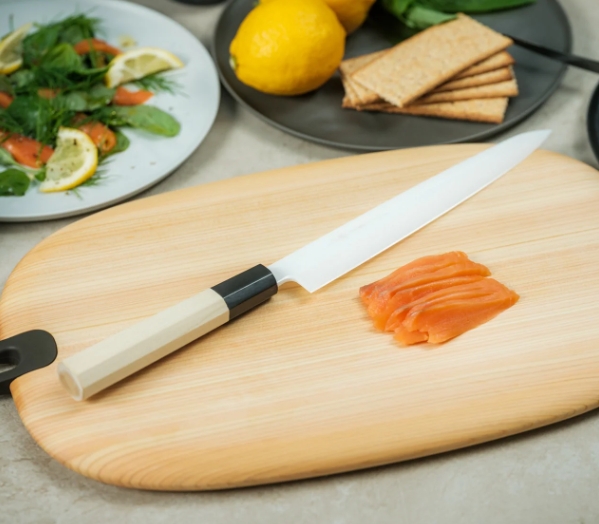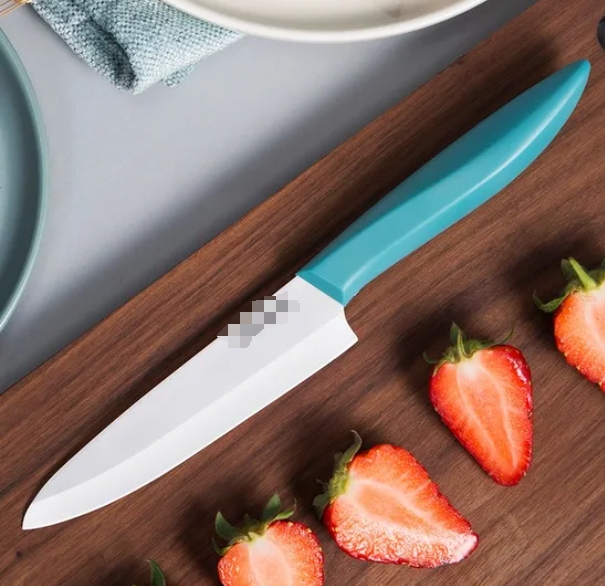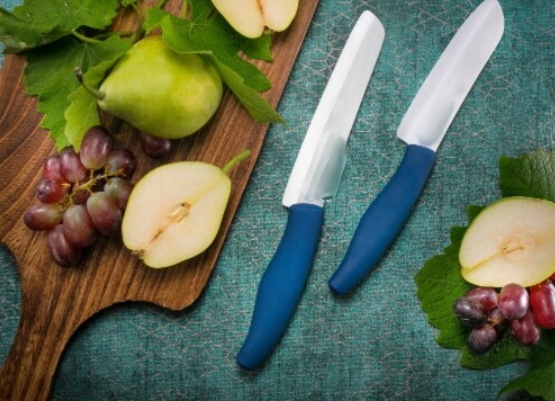

Views: 222 Author: Ella Publish Time: 2025-04-29 Origin: Site








Content Menu
● Why Knife Maintenance Matters
● The Fundamentals of Knife Care
● Cleaning Your Kitchen Knife: Step-by-Step
● Drying and Oiling: Preventing Rust and Corrosion
● Sharpening vs. Honing: What's the Difference?
● Choosing the Right Cutting Board
● Special Care for Different Knife Materials
● Advanced Knife Maintenance Techniques
● The Role of Regular Inspections
● Knife Safety Tips for Everyday Use
● FAQ: Top 5 Questions About Kitchen Knife Maintenance
>> 1. How often should I sharpen my kitchen knife?
>> 2. What's the difference between honing and sharpening?
>> 3. Can I put my kitchen knife in the dishwasher?
>> 4. What type of cutting board is best for my knives?
>> 5. How do I prevent my carbon steel knife from rusting?
Maintaining your kitchen knife is not just about preserving its sharpness-it's about ensuring safety, hygiene, and longevity for one of the most essential tools in your kitchen. Whether you're a home cook or a professional chef, understanding the best practices for knife care will transform your cooking experience and protect your investment for years to come.

A sharp, well-maintained kitchen knife is a joy to use and a cornerstone of efficient, safe food preparation. Yet, many knives end up dull, rusty, or damaged simply due to neglect or improper care. This comprehensive guide will walk you through every aspect of kitchen knife maintenance, from daily cleaning routines to advanced sharpening techniques, ensuring your knives stay razor-sharp and ready for any culinary challenge.
- Safety: A sharp knife is safer than a dull one because it requires less force and is less likely to slip.
- Performance: Well-maintained knives make precise, clean cuts, preserving the texture and flavor of your ingredients.
- Longevity: Regular care prevents rust, corrosion, and premature wear, extending the life of your knives.
- Hygiene: Proper cleaning and drying prevent bacterial buildup and food contamination.
- Aesthetics: A well-kept knife looks professional and inspires confidence in your kitchen skills.
- Always clean your knife immediately after use.
- Never put your knife in the dishwasher.
- Dry your knife completely before storing.
- Store knives properly to avoid damage.
- Regularly hone and sharpen your knives.
- Use the right cutting board to minimize blade wear.
- Avoid using your knife for tasks it wasn't designed for, such as prying open cans or cutting hard bones.
1. Rinse Immediately After Use
Hold the knife under running water and gently rub away food residue with your fingers or a soft sponge. Avoid touching the sharp edge directly for safety.
2. Use Mild Soap and Warm Water
Apply a small amount of dish soap to a non-abrasive sponge. Wipe both sides of the blade, moving from the spine toward the edge to avoid injury.
3. Avoid Soaking
Do not leave your knife soaking in water, as prolonged exposure can damage both the blade and handle, especially with wooden handles.
4. Clean the Handle
Wipe down the handle with a damp cloth, especially if it's wooden. Avoid excessive moisture on wooden handles to prevent swelling or cracking.
5. Rinse and Inspect
Rinse thoroughly to remove all soap and food particles. Inspect the blade for any remaining debris or stains.
1. Dry Immediately
Use a clean, absorbent towel to dry the blade and handle thoroughly. Never air-dry your knife, as water spots can lead to rust.
2. Oiling the Blade (Especially for Carbon Steel)
Apply a thin layer of food-safe oil (such as camellia or mineral oil) to the blade to create a protective barrier against moisture and acids. Use a paper towel to distribute the oil evenly, being careful around the sharp edge.
3. Maintain the Handle
For wooden handles, occasionally treat with a small amount of food-safe oil to prevent drying and cracking.
Sharpening and honing are often confused, but they serve different purposes in knife maintenance.
- Sharpening: This involves grinding away metal to recreate a sharp edge. It should be done with a whetstone, sharpening stone, or by a professional if you're unsure. Sharpening is needed when your knife becomes dull and struggles to cut cleanly.
- Honing: This realigns the microscopic edge of the blade, keeping it sharp and effective. Honing should be done with a honing rod suited to your knife's steel hardness, ideally before or after each use.
Sharpening is less frequent, perhaps every few months, while honing can be a daily or weekly routine depending on usage.
Proper storage is essential for maintaining your knife's edge and ensuring safety in the kitchen.
- Magnetic Knife Strip: Keeps knives accessible and prevents dulling from contact with other utensils.
- Knife Block: Protects blades but ensure the slots are clean and dry. Remove and clean the block periodically to avoid mold and bacteria buildup.
- Knife Sheath or Saya: Ideal for individual protection, especially for high-end knives. These covers protect the blade during storage or transport.
- Knife Roll or Wrap: Perfect for transporting knives safely, especially for culinary professionals or enthusiasts who travel with their tools.
The surface you cut on has a significant impact on your knife's longevity.
- Best Choices: End-grain wood or high-quality plastic boards are gentle on knife edges. End-grain boards, in particular, allow the blade to sink between the wood fibers, minimizing wear.
- Avoid: Glass, marble, granite, or ceramic boards, as they can quickly dull or chip your blade. These hard surfaces may also cause dangerous slippage.
Regularly clean and sanitize your cutting boards, and replace them if they become excessively worn or grooved, as deep grooves can harbor bacteria.
Stainless Steel Knives
- More resistant to rust but not immune. Clean and dry promptly after use. Stainless steel is generally easier to maintain but can still suffer from staining if neglected.
Carbon Steel Knives
- Prone to rust and discoloration. Clean immediately after cutting acidic foods, dry thoroughly, and oil regularly. Over time, carbon steel develops a patina, which protects against further corrosion and gives the blade a unique character.
Damascus and Specialty Knives
- Treat as you would high-carbon steel, with extra care during cleaning and storage. Avoid abrasive cleaners that could damage the intricate patterns on the blade.
Ceramic Knives
- Ceramic knives require different care. They are extremely hard and stay sharp for a long time but can chip or break easily. Only use them on soft foods and never attempt to sharpen them with regular stones.

- Dishwasher Use: The heat, moisture, and agitation can damage both blade and handle.
- Improper Storage: Tossing knives in a drawer leads to nicks, dulling, and accidents.
- Cutting Hard Materials: Avoid bones, frozen foods, or hard surfaces that can chip or bend the blade.
- Neglecting Regular Maintenance: Skipping honing or sharpening leads to dull, unsafe knives.
- Using the Wrong Tools: Never use a knife as a screwdriver, can opener, or pry bar.
- Letting Food Dry on the Blade: Acidic or salty residues can cause staining and corrosion if left on the blade.
For those who want to take their knife care to the next level, consider these advanced practices:
- Polishing the Blade: Use a fine polishing compound and a soft cloth to remove minor stains and restore shine. This is especially useful for high-carbon or Damascus steel knives.
- Blade Thinning: Over time, repeated sharpening can thicken the blade behind the edge. Skilled users can thin the blade using coarse stones to maintain optimal cutting performance.
- Edge Geometry: Experiment with different edge angles depending on your cooking style. Japanese knives often have a more acute angle for precision, while Western knives may have a slightly wider angle for durability.
Regularly inspecting your knives helps you catch problems early before they become serious.
- Check for Chips or Cracks: Examine the blade for any chips, cracks, or bends. Even small imperfections can affect performance and safety.
- Inspect the Handle: Look for loose rivets, cracks, or signs of wear. A secure handle is crucial for safe operation.
- Test the Sharpness: Use the paper test or tomato test to check if your knife is still sharp. If it struggles, it's time to hone or sharpen.
Proper maintenance goes hand-in-hand with safe handling practices.
- Use the Right Knife for the Task: Don't use a delicate slicing knife to cut through bones or frozen foods.
- Grip the Knife Correctly: Hold the handle firmly and keep your fingers away from the edge.
- Cut Away from Your Body: Always direct the blade away from your body and keep your non-cutting hand in a claw position to protect your fingers.
- Store Safely: Keep knives out of reach of children and always store them securely.
Proper kitchen knife maintenance is a simple yet crucial habit that pays dividends in safety, performance, and the longevity of your tools. By following the best practices outlined in this guide-cleaning promptly, drying thoroughly, honing regularly, sharpening as needed, and storing correctly-you'll ensure your knives remain sharp, safe, and a pleasure to use for years to come. Remember, a well-maintained knife is not only a sign of respect for your craft but also a testament to your commitment to quality and safety in the kitchen. Make knife care a regular part of your culinary routine, and you'll be rewarded with tools that perform beautifully every time you cook.

Sharpen your knife every few months or when you notice it struggling to cut cleanly. For most home cooks, two to four times a year is sufficient, but frequent use may require more regular sharpening.
Sharpening removes metal to restore a dull edge, while honing realigns the existing edge to maintain sharpness. Honing should be done before or after each use, while sharpening is less frequent.
No. Dishwashers can damage both the blade and handle due to heat, moisture, and contact with other utensils. Always wash knives by hand.
Use end-grain wood or high-quality plastic boards. Avoid glass, stone, or ceramic surfaces, which can dull or damage your blade.
Clean and dry your knife immediately after use, especially after cutting acidic foods. Apply a thin layer of food-safe oil to the blade before storage to protect against moisture and corrosion